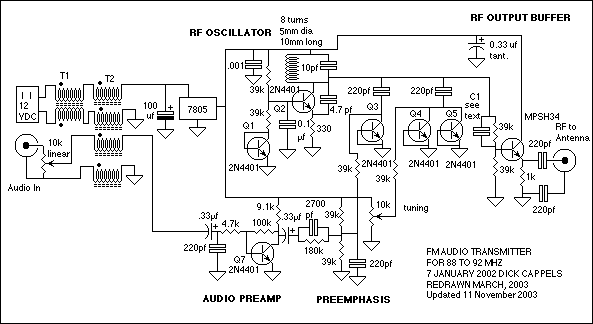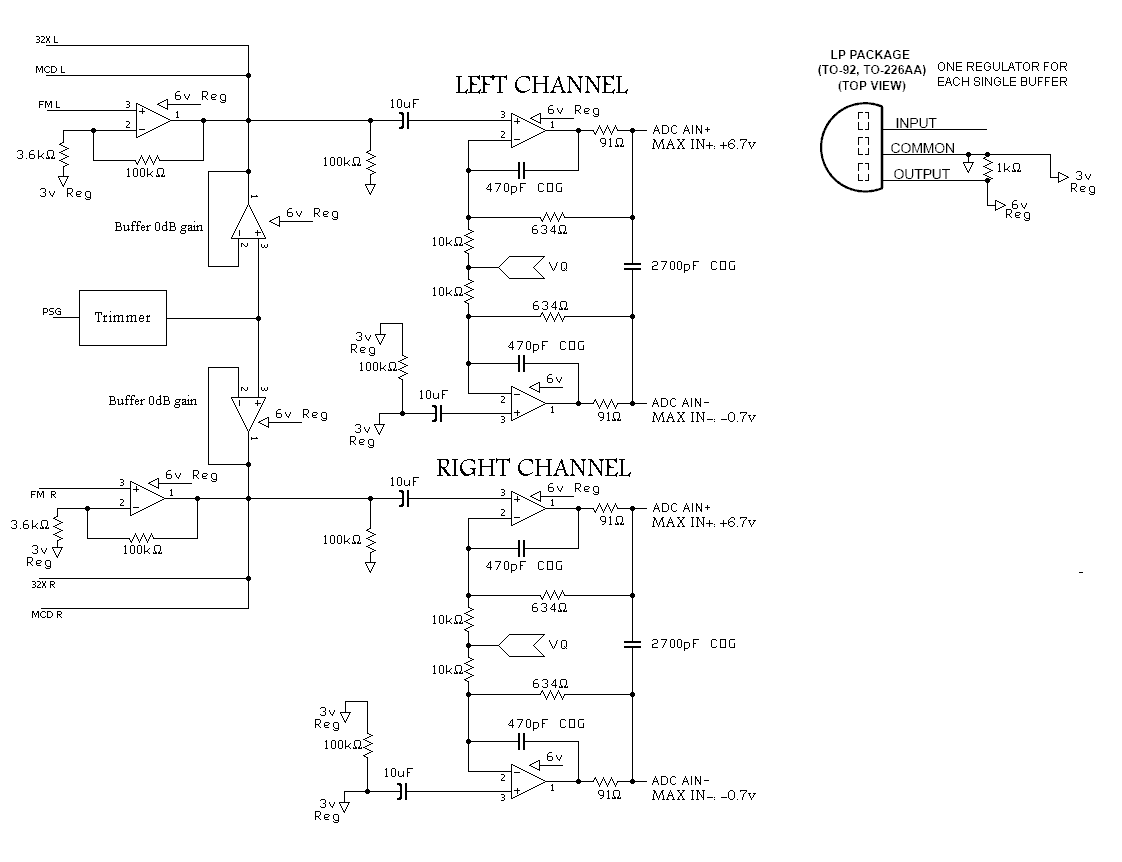
usb audio multiplexer

The audio ground is completely isolated from the digital ground. The top copper layer is utilized as a shield for both the audio and digital ground, which aids in preventing the audio section from picking up noise from the digital circuitry and other electromagnetic interference (EMI). The relay is not directly connected to the microcontroller unit (MCU) pin; instead, it is connected through resistor R3 and capacitor C2. This configuration is designed to reduce relay power consumption from 28 mA to approximately 12 mA. This technique is particularly beneficial when the device is connected through a USB hub with multiple devices, where even a reduction of ~15 mA can be significant. However, implementing this reduction is not mandatory. Pin PB3 of the MCU is connected to the CBUS3 pin of the FT232R with a 10 kΩ pull-up resistor, which can be utilized for power-saving functions or to provide a clock signal to the ATmega13A. The functions of the CBUS pins of the FT232R can be modified using the FT_Prog software available on the FTDI website. Initially, a single-sided board was considered, but the design ultimately resulted in a double-sided board. Consequently, the USB connector is located on the bottom of the board, while the audio connectors are positioned on the top. This arrangement can be altered if desired. If the specific relay used in this design is unavailable, any DPDT (2 Form C) 5VDC signal relay that does not exceed the maximum pin current of the ATtiny13 can be used. For different relay types, adjustments to the values of R3 and C2 may be necessary; however, if power savings are not a concern, a jumper can be placed instead. The design aimed for a low-cost microcontroller, preferably from Atmel or Microchip, with a minimal number of pins and hardware UART functionality. The smallest and most affordable option found was the Microchip PIC16F688T. However, since 14 pins were deemed excessive for this task, the ATtiny13A was selected, which was readily available. A software UART was developed for this microcontroller using the AVR304 application note from Atmel, specifically the Half Duplex Interrupt Driven Software UART. An 8-bit timer and one external interrupt were employed, although this may be excessive for the application. It is possible to implement a software UART with minimal memory usage without external interrupts and timers. Calibration issues with the ATtiny13 internal RC oscillator presented challenges, as the UART protocol is sensitive to frequency variations. The internal oscillator is calibrated at 3V and 25 degrees Celsius, while this audio multiplexer operates directly from a 5V USB port, potentially causing malfunction after firmware flashing. Adjustments to the number of timer cycles in the firmware may be required, with relevant comments provided in the code. To address this, CBUS3 of the FT232R could be configured as a clock source for the ATtiny13, leveraging the FT232R's internal RC oscillator for improved precision. Alternatively, an external crystal could be used for the FT232R while still utilizing CBUS3 as the clock source for the ATtiny13, which would be the ideal solution. A comparison of the frequency stability of the FT232R internal oscillator against that of the ATtiny13A could be conducted for further insights.
The circuit design incorporates several key components and configurations that enhance its functionality and efficiency. The isolation of the audio ground from the digital ground using the top copper layer as a shield is a critical feature that minimizes interference, ensuring high-quality audio output. The relay control circuit, including resistor R3 and capacitor C2, serves to optimize power consumption, which is essential for battery-operated or USB-powered devices where current draw is a consideration.
The choice of the ATtiny13A as the microcontroller is notable for its compact size and low pin count, making it suitable for simple applications while still allowing for the implementation of a software UART. The use of an external interrupt and timer for the software UART, although potentially over-engineered for this application, demonstrates a thorough approach to ensuring reliable serial communication. The calibration of the internal RC oscillator is a critical factor that requires attention, as it directly impacts the performance of the UART protocol.
In terms of flexibility, the ability to modify the functions of the FT232R's CBUS pins provides additional versatility, allowing the designer to adapt the circuit for various use cases. The design's adaptability extends to the choice of relays, enabling the use of alternative components without significant redesign, provided that the electrical specifications are adhered to. Overall, this schematic description outlines a well-considered approach to designing an audio multiplexer that balances performance, power efficiency, and flexibility, making it suitable for a range of applications.As you can see, the audio ground completely isolated from digital ground. And I`m using top copper layer as a shield for both, audio and digital ground. This helps to isolate audio part from picking up noise from digital circuitry and other EMI. Relay connected not straight to MCU pin, but it is connected through R3 and C2. It`s made for lowering relay power consumption from 28mA to about 12mA. I wrote about this trick in my article: Using Relays (Tips & Tricks). This might be helpful when this device is connected through usb-hub full of devices, when even ~15mA can make a difference. But it is not necessary implement this. Pin PB3 of MCU connected to CBUS3 pin of FT232R with 10k pull-up resistor, which can be used for power saving functions, or it can be used for providing clock to ATmega13A.
You can change functions of CBUS pins of FT232R using FT_Prog software which you can download from FTDI website At first I wanted to make single-sided board, but eventually I`ve end up with double-sided one. Because of that the USB connector stayed on the bottom of the board and audio connectors on the top. But if you want you can easily change that fact. If you can`t find the exact relay I`ve used in this design, you can use any DPDT (2 Form C) 5VDC signal relay which not exeeds ATtiny13 maximum pin current.
And for different relay you might need to change R3 and C2 values (if you don`t care about saving a couple of dozen of milliamps, just put jumper in there). For this simple task I was looking for cheap microcontoller(preferably from Atmel of Microchip) with minimal number of pins and with hardware UART.
But the smallest and cheapest thing I found was the PIC16F688T from Microchip. Well, I guess 14 pins is too much for this task, so I`ve ended up using ATtiny13A, which, btw I had in my junk box. I just decided to write software UART for this micro. To do that I`ve used AVR304 app-note from Atmel Half Duplex Interrupt Driven Software UART . I`ve used 8-bit timer and one external interrupt to do that, but for this simple task it`s actually is overkill.
It is possible to use only a small fraction of memory to implement software UART without using external interrupts and timers. Anyways, if you want you can still do that. The only issue I had with this device was ATtiny13 internal RC oscillator calibration. UART protocol is very sensitive to changes in oscillator frequency. ATtiny13 internal oscillator is calibrated under 3V and 25 degrees C, but in this Audio Multiplexer it`s powered straight from USB port 5V, and because of that it can even not work after you will flash the firmware.
You might need to tweak number of timer cycles in firmware (read comments in code, there`s only two values at the beginning of the program). To conquer that you might try to configure CBUS3 pin of FT232R as a clock source for ATtiny13, hoping that FT232R internal RC oscillator is more precise than ATtiny`s oscillator.
Or put external crystal for FT232R and still use CBUS3 as ATtiny13 clock source that would`ve been the ideal solution. I maybe will compare FT232R internal oscillator frequency stability against ATtiny13A internal oscillator.
Maybe. If you`ll try to do that before me, it would be interesting to know what the result is. 🔗 External reference
The circuit design incorporates several key components and configurations that enhance its functionality and efficiency. The isolation of the audio ground from the digital ground using the top copper layer as a shield is a critical feature that minimizes interference, ensuring high-quality audio output. The relay control circuit, including resistor R3 and capacitor C2, serves to optimize power consumption, which is essential for battery-operated or USB-powered devices where current draw is a consideration.
The choice of the ATtiny13A as the microcontroller is notable for its compact size and low pin count, making it suitable for simple applications while still allowing for the implementation of a software UART. The use of an external interrupt and timer for the software UART, although potentially over-engineered for this application, demonstrates a thorough approach to ensuring reliable serial communication. The calibration of the internal RC oscillator is a critical factor that requires attention, as it directly impacts the performance of the UART protocol.
In terms of flexibility, the ability to modify the functions of the FT232R's CBUS pins provides additional versatility, allowing the designer to adapt the circuit for various use cases. The design's adaptability extends to the choice of relays, enabling the use of alternative components without significant redesign, provided that the electrical specifications are adhered to. Overall, this schematic description outlines a well-considered approach to designing an audio multiplexer that balances performance, power efficiency, and flexibility, making it suitable for a range of applications.As you can see, the audio ground completely isolated from digital ground. And I`m using top copper layer as a shield for both, audio and digital ground. This helps to isolate audio part from picking up noise from digital circuitry and other EMI. Relay connected not straight to MCU pin, but it is connected through R3 and C2. It`s made for lowering relay power consumption from 28mA to about 12mA. I wrote about this trick in my article: Using Relays (Tips & Tricks). This might be helpful when this device is connected through usb-hub full of devices, when even ~15mA can make a difference. But it is not necessary implement this. Pin PB3 of MCU connected to CBUS3 pin of FT232R with 10k pull-up resistor, which can be used for power saving functions, or it can be used for providing clock to ATmega13A.
You can change functions of CBUS pins of FT232R using FT_Prog software which you can download from FTDI website At first I wanted to make single-sided board, but eventually I`ve end up with double-sided one. Because of that the USB connector stayed on the bottom of the board and audio connectors on the top. But if you want you can easily change that fact. If you can`t find the exact relay I`ve used in this design, you can use any DPDT (2 Form C) 5VDC signal relay which not exeeds ATtiny13 maximum pin current.
And for different relay you might need to change R3 and C2 values (if you don`t care about saving a couple of dozen of milliamps, just put jumper in there). For this simple task I was looking for cheap microcontoller(preferably from Atmel of Microchip) with minimal number of pins and with hardware UART.
But the smallest and cheapest thing I found was the PIC16F688T from Microchip. Well, I guess 14 pins is too much for this task, so I`ve ended up using ATtiny13A, which, btw I had in my junk box. I just decided to write software UART for this micro. To do that I`ve used AVR304 app-note from Atmel Half Duplex Interrupt Driven Software UART . I`ve used 8-bit timer and one external interrupt to do that, but for this simple task it`s actually is overkill.
It is possible to use only a small fraction of memory to implement software UART without using external interrupts and timers. Anyways, if you want you can still do that. The only issue I had with this device was ATtiny13 internal RC oscillator calibration. UART protocol is very sensitive to changes in oscillator frequency. ATtiny13 internal oscillator is calibrated under 3V and 25 degrees C, but in this Audio Multiplexer it`s powered straight from USB port 5V, and because of that it can even not work after you will flash the firmware.
You might need to tweak number of timer cycles in firmware (read comments in code, there`s only two values at the beginning of the program). To conquer that you might try to configure CBUS3 pin of FT232R as a clock source for ATtiny13, hoping that FT232R internal RC oscillator is more precise than ATtiny`s oscillator.
Or put external crystal for FT232R and still use CBUS3 as ATtiny13 clock source that would`ve been the ideal solution. I maybe will compare FT232R internal oscillator frequency stability against ATtiny13A internal oscillator.
Maybe. If you`ll try to do that before me, it would be interesting to know what the result is. 🔗 External reference
Warning: include(partials/cookie-banner.php): Failed to open stream: Permission denied in /var/www/html/nextgr/view-circuit.php on line 713
Warning: include(): Failed opening 'partials/cookie-banner.php' for inclusion (include_path='.:/usr/share/php') in /var/www/html/nextgr/view-circuit.php on line 713





